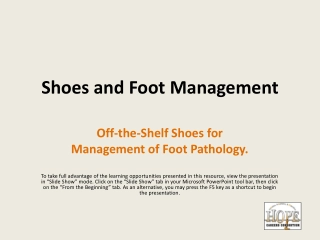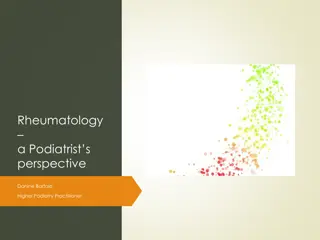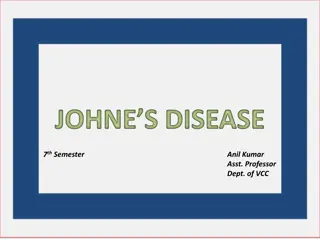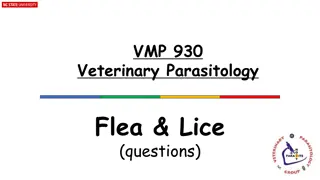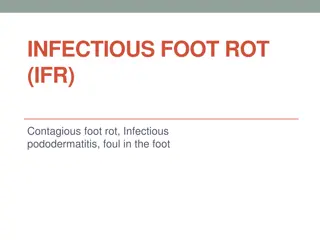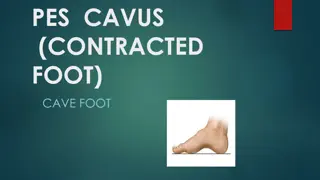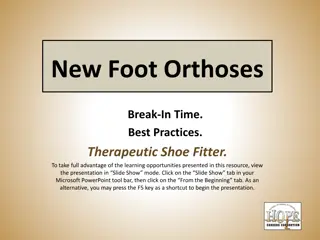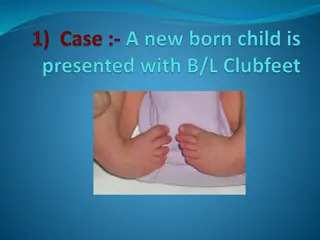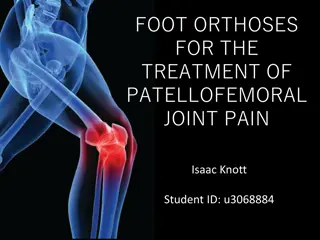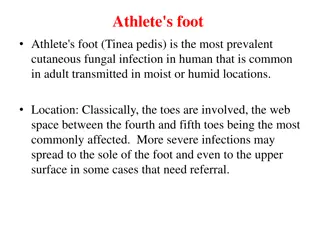Understanding Foot Rot and Digital Dermatitis in Ruminants
This detailed presentation covers Foot Rot (Bovine Foot Rot) and Digital Dermatitis (DD) in ruminants, discussing the etiology, symptoms, treatment, prevention strategies, and more. Foot Rot is caused by Fusobacterium necrophorum while DD is a contagious disease involving multiple bacteria. Treatment involves antibiotics, analgesics, and supportive care, while prevention focuses on environmental hygiene, nutrition, and early intervention.
Download Presentation

Please find below an Image/Link to download the presentation.
The content on the website is provided AS IS for your information and personal use only. It may not be sold, licensed, or shared on other websites without obtaining consent from the author. Download presentation by click this link. If you encounter any issues during the download, it is possible that the publisher has removed the file from their server.
E N D
Presentation Transcript
Foot Rot/Digital Dermatitis VCM-602/VMD602 Ruminant Medicine II Dr. Ranveer Kumar Sinha Assistant Professor cum Junior Scientist E-mail: ranveervet@rediffmail.com Department of Veterinary Medicine Bihar Veterinary College, Patna 800 014 (BASU, Patna)
INTRODUCTION Dewclaws: Just distal to the fetlock joint Tool for detecting generalized swelling in the foot Bovine Foot Rot (BFR): Foul of the foot, interdigital necrobacillosis, interdigital phlegmon Bacterial infection of the interdigital skin and subcutaneous tissue Foot becomes visibly swollen above the coronary band
ETIOLOGY BFR: Development of disease: Fusobacterium necrophorum Bacteria -Source: GI tract & therefore manure Interdigital skin has to be damaged by: Wetness & feces, maceration, Abrasions BFR epidemiology: Wetness and poor hygiene Pens with poor slope Not contagious
TREATMENT Injectable antibiotics (ABs) Ceftiofur, oxytetracycline, penicillin, ampicillin for 3-5 days Topical AB Iodine under bandage Analgesics: Flunixin or aspirin Suuportive: Antihistaminic, Sodabicarb etc
PREVENTION Beneath! Environmental hygiene - Proper slope and drainage to pens Adequate nutrition for resilient skin - Zinc, Copper, Biotin, Iodine Footbaths Educate: Early intervention
DIGITAL DERMATITIS (DD) Digital Dermatitis (DD) hairy heel warts, papillomatous digital dermatitis A contagious disease that appears to be caused by multiple bacteria acting together Spirochetes (Treponema) involved Typical location: Interdigital skin just above the heels Mild to moderate lameness Begins as a red, eroded, granular area, slowly expands in size
RISK FACTOR Development of Disease in DD: Rear legs > Fore; suggesting exposure to manure, shorter heels of hind feet may predispose Risk factors for DD: Poor hygiene and wet conditions Introduction of new animals without quarantine it s a contagious disease Inanimate objects (fomites): hoof trimming equipment, dirty boots
TREATMENT Topical antiseptics or antibiotics under a light bandage Flunixin meglumine or aspirin for pain if severe Resolve quickly with treatment (2-4 days) Copper sulfate powder under a bandage Iodine mixed together into an ointment under a bandage
PREVENTION Spray hind feet with: Disinfectant antiseptic antibiotic solution Prevention of DD: Clean tools, hoof knives, boots; clean coveralls on each premise


